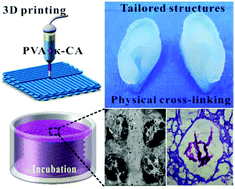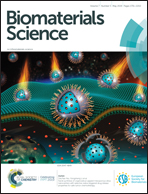Direct ink writing with high-strength and swelling-resistant biocompatible physically crosslinked hydrogels†
Abstract
The three-dimensional (3D) printing of hydrogels has great potential for biomedicine applications. However, it is very rare to find suitable printable materials with high strength and swelling resistance that can offer high performance. To address this challenge, this paper demonstrates the fabrication of tailored hydrogel structures by using the direct ink writing (DIW) of hybrid hydrogel inks (polyvinyl alcohol (PVA) and κ-carrageenan) with outstanding rheology. The freezing and thawing processes following DIW induce the formation of physically crosslinked networks due to the crystallinity of PVA, and thus enhance the mechanical properties and swelling resistance of the printed architectures. The resultant hydrogels exhibit excellent cytocompatibility, and most importantly, cells not only attach well to the surface of the hydrogels, but also stretch into the spaces in the grid architectures, providing appropriate microenvironments for cell culture. The physically crosslinked hydrogels, with high strength, outstanding swelling resistance, biocompatibility, and good compatibility with the DIW technique, offer many opportunities in fields such as tissue engineering, drug delivery, bone regeneration and implant medicine.



 Please wait while we load your content...
Please wait while we load your content...